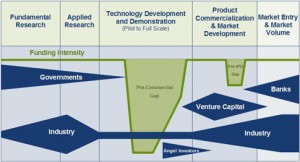 In 1981, MTV famously launched itself by playing the Buggles video “Video Killed The Radio Star”. While this prediction didn’t come true, radio’s influence in the music business was certainly diminished. MTV had come up with a new business model that disrupted radio’s dominance. The record industry would face an even more disruptive force as Napster and the mp3 brought file sharing the to the masses. Apple’s suggestion that we “Rip. Mix. Burn.” and carry “1,000 songs in your pocket” brought a new business model to the music business. Record companies have yet to fully adapt.
In 1981, MTV famously launched itself by playing the Buggles video “Video Killed The Radio Star”. While this prediction didn’t come true, radio’s influence in the music business was certainly diminished. MTV had come up with a new business model that disrupted radio’s dominance. The record industry would face an even more disruptive force as Napster and the mp3 brought file sharing the to the masses. Apple’s suggestion that we “Rip. Mix. Burn.” and carry “1,000 songs in your pocket” brought a new business model to the music business. Record companies have yet to fully adapt.
Surprisingly, other areas of the entertainment and media businesses have been slow to learn from this experience. Netflix started offering its DVD by mail subscription service in 1999. Apple starting selling movies through iTunes in 2006 and Netflix Instant Watching launched in 2007. Fast forward to last month when Blockbuster entered bankruptcy protection in the United States. With all of this recent history to learn from, why didn’t Blockbuster buy Netflix for $50 million when it had the chance? Why did it keep opening costly stores when it could see the landscape changing?
I think this has a couple of lessons for entrepreneurs. First of all, your business model is not safe. It might not be technology or the internet that makes it irrelevant. It could be lower priced labour in China. It’s not good enough to react to things after they have happened. Blockbuster tried to start a DVD by mail service to compete with Netflix. It was too late. Entrepreneurs have to be alert and proactively respond to a changing environment. Business owners don’t have to be paranoid about what the competition is doing but they have to at least notice the storm clouds on the horizon. Be ready to make changes to your business model if the situation warrants it.
David can slay Goliath. Many large corporations don’t see change coming and if they do, they cannot move fast enough to take advantage of it. Blockbuster was saddled with rent on 4,000 physical stores, which led to year after year of billion dollar losses. By the time they saw the writing on the wall, they couldn’t change fast enough to stave off bankruptcy. Blockbuster once accounted for 40% of movie studios’ revenues and an upstart like Netflix has managed to out manoeuvre it.
What will be next? Indigo continues to build new bookstores while digital books come on strong. Cable and satellite companies continue to force packages of channels on their customers while Apple, Google, and Netflix offer à la carte services. Upstarts like Roku are getting in on the action by offering hardware to deliver this content. A startup can succeed against a entrenched competitor if it offers a unique value proposition.







